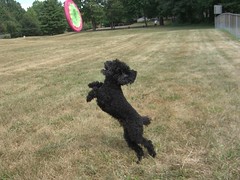
Originally uploaded by GoofyGirl.
The maker of the Segway scooter on Monday unveiled the second generation of its self-balancing electric one-person vehicle.
The redesigned scooter allows the rider to steer by leaning to the right or left, rather than by turning the handlebars. It also features a wireless electric key and alarm system.
The scooters feature two side-by-side wheels, and are ridden in a standing position, with the rider grasping handlebars. A gyroscope provides balance, making it fairly easy to remain in the upright position.
Officials at Bedford, New Hampshire,-based Segway Inc. said they have sold tens of thousands of the scooters since they were unveiled with great fanfare in 2002.
The scooters have been adopted by some police and security services in the United States and abroad, but remain an uncommon site on American streets.
Dave Howells, an information desk manager at Boston's Museum of Science, sometimes rides one at work as he mingles with visitors, but said he didn't believe the scooter -- priced at $5,000 to $6,000 depending on configuration -- would be practical for day-to-day use.
"I don't know if I would purchase one for my own use," he said. "Most of the places I'm going to go, I need a car. I live out in Marblehead, and it's hard enough to get around on a bike. The roads are congested, and you have to be careful."
But technology consultant Marc Hodosh said he's been using a Segway to commute from his home in Brookline, Massachusetts, just outside Boston, to meetings downtown for the past 3-1/2 years, covering 10 to 20 miles a day.
"It is, in my opinion, the best way to get around Boston," Hodosh said. "There are no issues of parking, there are no faster ways to get through Boston at rush hour, you don't pay anything for gas, as there is none. And on top of that, it's a lot of fun."
The electric scooters have a top speed of 12.5 miles per hour and take 8 hours to fully charge in standard wall outlets. The street model can travel up to 24 miles on a single charge. The company also makes an off-road model.
The scooters are available in a variety of configurations for commuters and commercial users. There's even one designed to carry a golf bag.
Company officials rebuff questions about precisely how many scooters they've sold, citing their private ownership. However, they said Segway may consider an initial public offering in the coming years.
TRICKY TURNS
Klee Kleber, vice president of marketing at Segway, said the new steering technology was intended to make the scooter easier to ride
"With the original steering ... you had to coordinate how you leaned with how much you were turning the grip," Kleber said. "With the new version, you have it from the first time you get on it."
Shortening the learning curve is key for the company's commercial customers, such as security forces and factories, which may share one scooter among many riders.
One of the first U.S. golf courses to have adopted the off-road Segway is Hidden Lakes Golf Course, in Derby, Kansas. Some of its golfers have had trouble learning to turn.
"We have had a couple of people fall, and I think the reason they fall is they get moving at a decent speed and then when you turn with your hand, that thing turns on a dime," said Dave Davis, assistant golf professional at the course.
"Your momentum is going forward and the machine cuts straight left," Davis said. "And then next thing you know, you're over because the machine is going the opposite way."
The golfers who've fallen off the carts aren't alone. President Bush fell off one about three years ago, but landed on his feet.
The experience didn't seem to sour him on the scooters, though. Last year he gave one to Japanese Prime Minister Junichiro Koizumi as a gift.
